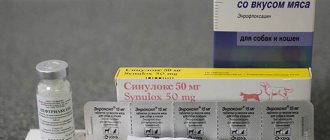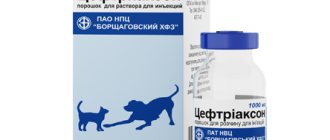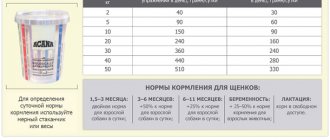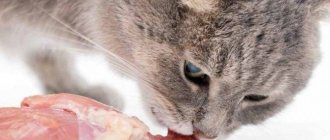For viral diseases, the use of drugs is permissible when the animal is at risk of complications. When prescribing, it is important to follow the dosage; the doctor calculates it depending on the dog’s body weight. Amoxiclav for dogs is an antibiotic that must be used correctly and under the supervision of a veterinarian. What medications can animals take, how to take them and how long to spend therapy is written in this article.
The antibiotic belongs to the category of penicillin, one of the simplest and safest drugs. There are a lot of antibiotic analogues. In total, there are about 20 of them. Amoxicillin suspension is more popular.
Composition and action
The therapeutic effect of Amoxiclav is ensured by the synergy of two active components:
- amoxicillin trihydrate provides an antibacterial effect, quickly destroys many pathogenic microorganisms, including staphylococci, Escherichia, clostridia, etc.;
- clavulanic acid – active against bacteria resistant to penicillin.
Amoxiclav is prescribed for the treatment of infectious diseases in dogs, primarily the respiratory tract, gastrointestinal tract, genitourinary system, soft tissues and skin.
Important!
Uncontrolled use of antibiotics can lead to serious health complications for the animal. Only a veterinarian can determine the need for use and choose the drug that is most effective against the causative agent of the disease.
Characteristics of the drug and composition
In veterinary medicine, a 15% solution is more often used because it is easier to dose. After taking the substance, it is instantly absorbed into the blood, where it remains for a long time (for two days) from the last dose. The maximum possible content of the substance is formed in the liver, kidneys, urinary system, and also in the tissues of the body. The drug is usually excreted from it with urine (over 90%), and in small proportions with bile.
Amoxiclav is manufactured for use in dogs in different forms:
- tablets;
- powders;
- for injection.
Additional elements of the drug:
- silica;
- sodium chloride
- talc;
- cellulose ethyl ether;
- titanium dioxide;
The dry mixture is supplied in dark glass bottles along with a measuring spoon. Contains 125 and 31.25 mg of active elements. When produced, 5 ml contains 2 times more active substances. Additional elements are considered:
- citric acid;
- sodium salt of citric acid;
- sodium salt of benzoic acid;
- cellulose gum;
- pyrogenic silicon dioxide;
- saccharin;
For injection, powder is produced in bottles from 0.6 to 1.2 g. The content of sodium salt in the solution is 500, 1000 mg, and potassium - 100 - 200 mg. Pack of 5 pcs.
The tablets contain two components, amoxicillin (250 mg) and clavulanic acid (125 mg). The medication is used in the treatment of salmonella and staphylococci. The medicine is not effective in treating pseudomonas - a naturally occurring bacteria that is common in soil and water bodies. The medication is well absorbed from the gastrointestinal tract, producing an antibacterial effect for 12 hours.
Purpose
Antibiotics are a serious group of drugs. They are prescribed for infectious diseases, after injuries and surgical interventions to prevent the development of secondary infections. Depending on the causative agent of the disease, the veterinarian selects a drug.
Amoxiclav has a wide spectrum of antibacterial action and is used to treat infectious diseases caused by pathogenic microorganisms, including Salmonella, Clostridia, Escherichia, Staphylococcus, Streptococcus, Corynebacterium, Listeria, Haemophilus influenzae and other bacteria.
The drug is used to treat pets:
- for respiratory infectious diseases (pneumonia, rhinitis, bronchopneumonia);
- infections of the gastrointestinal tract (enteritis, bacterial diarrhea, salmonellosis);
- diseases of the urinary and reproductive systems (cystitis, endometritis, leptospirosis);
- mastitis in females;
- skin and joint lesions (abscesses, necrobacteriosis, arthritis).
For prophylactic purposes, the medicine is prescribed after operations to prevent infections caused by microorganisms sensitive to amoxicillin.
Among other respiratory diseases in dogs, infectious tracheobronchitis (other names are kennel cough or kennel cough) occurs. This is a complex of viral (primary) and bacterial (secondary) infections that affect the upper respiratory tract. It is believed that pathology in different countries and during different outbreaks can be caused by different viruses, and it is often accompanied by secondary infections that can be caused by pathogenic bacteria - streptococci, staphylococci, Klebsiella, Bordetella, mycoplasma, etc.
Side effects and contraindications of the drug
With normal dosage and strict adherence to the instructions and prescriptions of the veterinarian, there are practically no side effects. However, if owners try to “cure” the animal on their own, various unpleasant incidents occur. For example, allergies may appear. Allergies cause inflammation of the nasal mucosa, swelling of the soft tissues of the head, especially around the eyes, ears and muzzle, severe itching, and conjunctivitis. Sometimes the problem reaches anaphylactic shock and death. If you notice that the dog is lethargic after using the substance, do not continue to inject it with the medicine, but immediately seek help from a veterinarian.
First, you need to deal with the causative agent of the allergy and naturally eliminate it from the animal’s body. During a prolonged and uncontrolled “infusion” of a pharmaceutical substance, a violation of the ratio and composition of microorganisms inhabiting the intestines begins. The result is prolonged diarrhea. The dog is lethargic and vomiting. In animals, the intestinal microflora is already quite low, and from such a “cure” it suffers completely
If the dosage of the drug amoxiclav intended for a dog is significantly higher than the doctor prescribed (as a result of the owner’s self-treatment), disruptions in the process of formation and development of blood cells may occur, the liver and kidneys may suffer.
The use of the drug externally in the form of a dry substance, pills, and also internally by injection depends on the form of release. Remember! Injections are the best option. They make it possible to make the correct dosage. In the form of injections, the dosage of the substance for animals is used from 1 ml/10 kg of weight, and pills - 12.5 mg/kg of weight.
Prohibition on taking medication
Amoxiclav should not be taken by dogs with the following pathologies:
- with kidney and liver diseases. Please note that the substance treats nephritis of infectious origin. However, when given medications to an animal with chronic diseases, including liver failure, the substance can cause death. Remember! Before treatment begins, your dog must undergo blood and urine tests.
- The drug should not be prescribed to animals that have previously been treated with penicillin-type medications. Possible cumulative effects, overdose and allergies.
- for diseases of the hematopoietic system, penicillin-type substances are contraindicated; the drug can penetrate the placenta, and the percentage of this substance in the milk of lactating females is very high. Therefore, the use of the drug as a medicine by pregnant females is strictly prohibited.
- It is also prohibited to give to guinea pigs, rabbits, that is, herbivorous pets.
The substance must be stored in a dry, dark room at a temperature of 4-25ºС.
Shelf life: 2 years.
The medicine is manufactured in Slovenia.
Currently reading:
- What is the composition and review of Farmina dog food?
- Compositions, dosages of Hills food for all dogs
- What do people think about the composition of the food Meal for dogs?
- Seven Signs and Remedies for Getting Rid of Fleas in Dogs
Dosage
Amoxiclav tablets for infectious diseases are prescribed in a course of 5-7 days, the therapeutic dose is calculated based on the animal’s body weight:
- dogs weighing up to 5 kg – 1⁄4 tablets;
- up to 15 kg – half a tablet;
- from 15 to 25 kg – 1 tablet;
- further – 1⁄4 tablets for every 5 kg.
The tablets should be given twice a day, mixed with food or forcefully - directly into the mouth. In severe cases, the veterinarian may double the dose or extend the course of antibiotic therapy.
Important!
It is recommended to give the medicine every day at the same time, maintaining an interval of 12 hours between taking tablets.
In some cases, a different treatment regimen is recommended:
- for respiratory infections, treatment is carried out for 8-10 days;
- chronic dermatitis – up to three weeks;
- In chronic cystitis, antibiotic treatment can last up to 4 weeks.
general description
Most often, an antibiotic is used for dogs in the form of a suspension intended for intramuscular or subcutaneous injection. The outwardly white liquid is packaged in glass bottles, which are sealed with rubber stoppers and rolled up with aluminum lids to maintain tightness. The composition of the drug is based on amoxicillin in the form of trihydrate. Its concentration in the drug is 150 mg per 1 ml of suspension. It also contains an oily filler. It performs a special role - it ensures the long-term effect of the main component.
Note! You can store the medicine in an opened bottle for no more than 28 days.
The antibacterial agent is also available in the following pharmacological forms:
- Pills. May contain 0.25 and 0.5 g of active ingredient. The tablets are resistant to gastric juice and are quickly absorbed from the gastrointestinal tract.
- Powder for oral administration. The concentration of the active substance is 150 mg of amoxicillin per gram of powder. Packaged in polymer bags of various volumes - from 1 g to 1 kg.
The main active substance amoxicillin is a semisynthetic antibiotic of the penicillin series. Its main advantage is its wide spectrum of action. The drug is active against various gram-positive and gram-negative bacteria. These include:
- streptococci;
- staphylococci;
- salmonella;
- enterobacter;
- pseudomonas;
- erysipeloids;
- pasteurella;
- listeria, etc.
A complete list of bacteria against which Amoxicillin is effective when used in dogs can be read in the instructions included with the medication.
Dosage for an adult dog
In veterinary hospitals, Amoxicillin solution 15% is used in ampoules. It is injected subcutaneously into the withers of the animal, or, if indicated, into a vein.
The antibacterial drug Amoxicillin is prescribed based on the weight of the pet (1 ml of the drug per 10 kg of weight). More than 20 ml per injection is not prescribed.
This dosage applies to all breeds, regardless of age.
Tablets are given at the rate of 12.5 mg per 1 kg of weight, regardless of the breed or age of the pet. It is advisable to divide the daily dose into 2 doses.
The medication in powder form is added to the dog’s soft food or drink at the rate of 2 g per 10 kg of weight. One dose per day is enough. The duration of treatment is determined by the doctor. It can range from 4 to 6 days.
Dosage for puppies
For dogs older than six months, antibacterial medications are also prescribed depending on weight. Administration of the drug is contraindicated before 6 months of age. For all forms of medication, dosage calculations are similar to adult dogs.
You should focus on the mass of the young dog. You cannot simultaneously administer penicillin antibiotics (amoxicillin) to your puppy with other antibacterial and medicinal drugs.
In what cases is medication prescribed for cats?
Is it possible to prescribe Amoxiclav to a cat on its own? Veterinarians advise owners of pets, cats and dogs, to contact clinics if obvious signs of infectious diseases and other complications develop. In some cases, it is difficult for the pet owner to diagnose the disease “by eye” and prescribe adequate treatment. To determine the causative agent of the infection, clinical blood or urine tests are required.
Instructions for use of Amoxiclav for cats contain information that it can be used to treat a number of diseases caused by pathogens and infections that are sensitive to the components of the drug :
- upper respiratory tract;
- urinary system;
- stomach and intestines;
- genital area, including complications after childbirth.
Amoxiclav gives good results in the treatment of cats with purulent wounds and problems with the healing of postoperative sutures.
Composition of the drug, its principle of action
The drug is classified as an antibacterial penicillin drug. The active substance works in a similar way to ampicillin.
Amoxycillinum includes hydroxyl group drugs, which makes the drug effective when administered orally.
The basis of the drug is the semi-synthetic substance amoxicillin in the form of a simple trihydrate. It belongs to the penicillin series .
Additional chemicals: enterosorbent polyvidone, magnesium stearate.
Amoxicillin is a drug that is resistant to gastric juice and is characterized by rapid absorption. After administration, it penetrates into blood vessels and veins within an hour, which makes it highly effective.
The drug is excreted in the urine and partly in bile for several days.
The antibiotic acts on bacterial cells. With prolonged use, this leads to their complete destruction.
The product is effective against all bacteria (both gram-positive and negative), this is due to its wide spectrum of action.
Side effects
When administering the veterinary drug Amoxicillin 15%, side effects rarely occur. An antibiotic is a low-hazard substance. Swelling may occur at the injection site; it goes away on its own within a few days .
To exclude the occurrence of negative reactions, you should not mix the antibiotic with other medications in the form of injections. With long-term use, dysbacteriosis may occur.
For diarrhea, probiotics or prebiotics are prescribed.
If the dosage and rules for administering the antibiotic have not been violated, problems with the animal’s health will not arise.
Veterinary suspension in ampoules
To treat diseases in dogs, antibiotics are mainly used in liquid form - in the form of a suspension, which is intended for intramuscular or subcutaneous injections.
In some cases, amoxicillin is administered intravenously.
The white liquid is sold in glass bottles with rubber stoppers and rolled aluminum caps for tightness.
Dosage
The main advantage of amoxicillin in the form of a suspension is the simplicity of the antibiotic dosage. The amount of the drug required for a single administration to a dog is calculated according to the following scheme: 1 ml of suspension per 10 kg of dog weight. Another advantage of amoxicillin treatment is that the dosage does not depend on the age and breed of the pet; it is always the same for all age and breed groups of dogs.
How to inject?
In order not to cause your dog unnecessary suffering during treatment, it is important to be able to correctly administer the antibiotic. There is nothing wrong with these rules, but following them will help your pet reduce pain. Before you begin the injection, you should:
- Be sure to wash your hands.
- Take a sterile syringe, preferably disposable.
- Shake the ampoule until the suspension is homogeneous.
- Wipe the area where the ampoule is broken with an alcohol wipe or cotton wool soaked in alcohol.
- Open the ampoule and draw the drug into the syringe.
- Raise the syringe with the needle up and press the plunger, releasing any remaining air.
- The place chosen for the injection is wiped with an alcohol cotton swab.
Where to give the injection?
If an injection of amoxicillin is given to an animal intramuscularly: the antibiotic is injected into the thigh muscle of the dog's back leg. The injection is performed strictly perpendicular to the skin. The needle is inserted carefully, without sudden movements.
If it is necessary to give a subcutaneous injection: it is performed at the dog’s withers. The syringe is taken in the right hand, with the free hand the skin at the base of the withers is pulled back until a fold is formed. The syringe needle is inserted into the skin at an angle. The antibiotic is administered slowly.
If the prescribed dosage exceeds 20 ml, then injections should be done several times in different parts of the dog’s body. After the procedure, you should massage the injection site.
The antibiotic has a long-lasting effect and is highly effective, so the injection is given once. If the disease is advanced or severe, the veterinarian may decide to re-administer amoxicillin after two days.
Attention! It is strictly prohibited to use amoxicillin to treat dogs on your own, without a veterinarian’s prescription!











